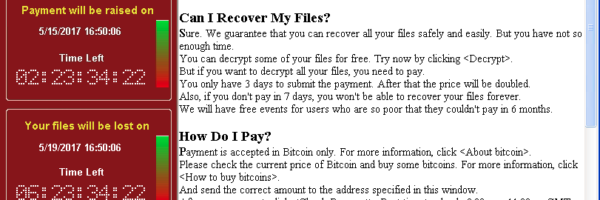Computer Security Alert: WannaCry ransomware
Dear all,
As you have probably seen on the news, this last weekend has been very intense for many organizations and individuals around the world. Fortunately for us, only 3 of our servers are running Windows, with the rest of our almost 40 servers running on Linux, which is known for its reliability and security.
Here is a small selection of relevant news articles:
- BBC: “Ransomware cyber-attack a wake-up call, Microsoft warns”
- The Guardian: “Massive ransomware cyber-attack hits nearly 100 countries around the world”
- Troy Hunt: “Everything you need to know about the WannaCry ransomware”
- The Hacker News: WannaCry Ransomware Cyberattack – which warns that this is not over yet, with Version 2 of the malware already causing problems.
If you are running Windows, you should make sure that your computer is fully updated. You can check this by opening Windows Update on your computer. For more detailed instructions, look at the bottom of this article.
Additionally, you should follow Microsoft’s recommendations to ensure your computer is safe:
- In March, we released a security update which addresses the vulnerability that these attacks are exploiting. Those who have Windows Update enabled are protected against attacks on this vulnerability. For those organizations who have not yet applied the security update, we suggest you immediately deploy Microsoft Security Bulletin MS17-010.
- For customers using Windows Defender, we released an update earlier today which detects this threat as Ransom:Win32/WannaCrypt. As an additional “defense-in-depth” measure, keep up-to-date anti-malware software installed on your machines. Customers running anti-malware software from any number of security companies can confirm with their provider, that they are protected.
- This attack type may evolve over time, so any additional defense-in-depth strategies will provide additional protections. (For example, to further protect against SMBv1 attacks, customers should consider blocking legacy protocols on their networks).
You can find their full document here. Please note that Windows XP, Windows Server 2003 and Windows 8 are NOT SUPPORTED anymore by Microsoft. However, due to the grave situation, they have also released fixes for these versions, in the document linked before.
We recommend that all users make sure that they have reliable and effective security products on their computers. At BIS, we recommend the following products, all of them free for personal use:
- Avira Antivirus, free for Windows and Mac, or…
- Avast Antivirus, free for Windows and Mac
- Additionally, we recommend anti-spyware and adware: MalwareBytes, free for Windows and Mac
Finally, if you are curious, here is a map of live infections of WannaCry. Quite scary!
Let us know if you have any questions or need help in ensuring your computer is safe.
Best regards,
Urko Masse
IT Manager – itmanager@baliis.net
Check For and Install Updates in Windows 10
In Windows 10, Windows Update is found within Settings.
First, tap or click on the Start menu, followed by Settings. Once there, choose Update & security, followed by Windows Update on the left.
Check for new Windows 10 updates by tapping or clicking on the Check for updates button.
In Windows 10, downloading and installing updates is automatic and will happen immediately after checking or, with some updates, at a time when you’re not using your computer.
Check For and Install Updates in Windows 8, 7 and Vista
In Windows 8, Windows 7, and Windows Vista, the best way to access Windows Update is via the Control Panel.
In these versions of Windows, Windows Update is included as an applet in Control Panel, complete with configuration options, update history, and lots more.
Just open Control Panel and then choose Windows Update.
Tap or click Check for updates to check for new, uninstalled updates. Installation sometimes happens automatically or may need to be done by you via the Install updates button, depending on what version of Windows you’re using and how you have Windows Update configured.
Check For and Install Updates in Windows XP, 2000, ME and 98
In Windows XP and previous versions of Windows, Windows Update is available as a service hosted on Microsoft’s Windows Update website.
Similar to the Control Panel applet and Windows Update tool in newer versions of Windows, available Windows updates are listed, alongside a few simple configuration options.
Checking for, and installing, uninstalled updates is as easy as clicking those respective links and buttons on the Windows Update website.
Important: Microsoft no longer supports Windows XP, nor versions of Windows that preceded it. While there may be Windows updates available for your Windows XP computer on the Windows Update website, any you see will be updates released prior to the end of support date for Windows XP, which was on April 8, 2014.
More on Installing Windows Updates
The Windows Update service is not the only way to install Windows updates. Like I mentioned above, updates to Windows can also be downloaded individually from Microsoft Download Center and then installed manually.
Another option is to use a free software updater program. Those tools are usually built specifically for updating non-Microsoft programs but some include a feature for downloading Windows updates. Most of the time, Windows updates are installed automatically on Patch Tuesday but only if Windows is configured that way.

